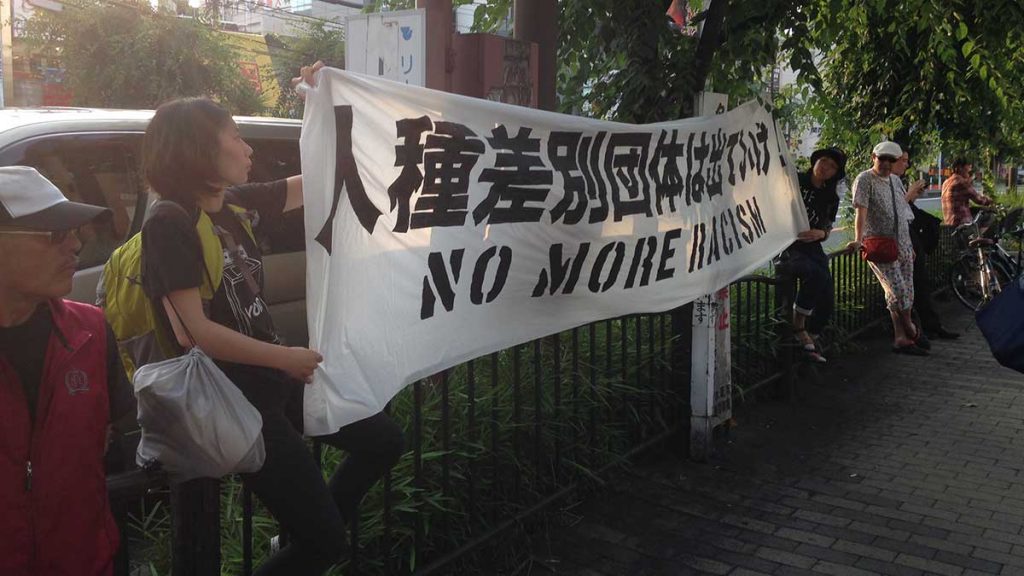Studies show that anti-Korean sentiment in Japan has grown steadily in the past decade, despite the growing acceptance of more visibly “foreign” Southeast Asian migrants in Japan. A University of Notre Dame researcher conducted two years of ethnographic fieldwork in a historic Korean ghetto in Osaka, Japan, to shed light on the legacy of discrimination that third- and fourth-generation Korean minorities have faced as the descendants of labor migrants under Japanese colonial rule from 1910 to 1945.
As Sharon Yoon, assistant professor of Korean studies at Notre Dame’s Keough School of Global Affairs, and her co-author, Yuki Asahina, at Hankuk University of Foreign Studies, point out in their recent paper in the journal Politics and Society, Korean minorities were deemed a danger to the political stability of Japan by the American Allied Forces and the Japanese government, and discriminatory laws excluded them from social welfare benefits, citizenship rights and mainstream employment throughout the postwar era. Until the 1980s, the vast majority of Korean minorities lived in squatter settlements where crime, poverty, and mental illness abounded. These xenophobic policies were overturned following Japan’s ratification of the International Covenant on Economic, Social and Cultural Rights; the International Covenant on Civil and Political Rights in 1979; and the UN Refugee Convention in 1982.
Members of Japan’s new far right, known as the “Zaitokukai” (short for Zainichi Tokken wo Yurusanai Shimin no Kai, or Citizens Against the Special Privileges of Koreans in Japan), are angry that Koreans are granted what they believe is unfair access to “public assistance not available to other foreigners, by positioning themselves as victims of the Japanese empire.” The far-right group aims to undo the legal apparatus granting Koreans these so-called special privileges.
“While their numbers are decreasing with increasing rates of naturalization and intermarriage with Japanese nationals, Koreans have become the primary target of the far right because of their symbolic place in postwar Japanese discourse as the Other,” said Yoon, also an affiliate of the Liu Institute for Asia and Asian Studies.
Despite Japan’s low rates of immigration compared to the West, Yoon and Asahina were intrigued to find many structural similarities between Japan’s new far right and those in Europe and the US.
“Although many scholars have highlighted the rise of the Zaitokukai as unique to Japan’s particular historical legacy as a former colonizer in Asia, we need to analyze Japan’s new far right within the broader literature on hate groups in the West,” said Yoon. “Japan has experienced minimal rates of immigration, but the impending doom and perception of fear that is spread by the new far right make it seem as if the Korean minorities are responsible for Japan’s stagnating economy.”
Since 2012, the new far right has moved from spreading hate on online forums to organizing anti-Korean street protests. The Japanese Ministry of Justice reported that the hate group organized 1,152 hate rallies in Japan between April 2013 and September 2015. The group has also frequently targeted Korean schools and in 2009 and 2010; “far right activists were filmed taunting Korean children with racial slurs while banging on the metal gates at the [Kyoto No. 1 Korean elementary] school’s entrance for over an hour,” the authors wrote. Ultimately, a group of human rights activists and concerned parents at the school sued the Zaitokukai. The Japanese Supreme Court ruled in the school group’s favor and fined the Zaitokukai $120,000 in 2013.
Though much attention has been paid to the far-right group’s extremist hate rallies, Yoon and Asahina point to the broader influence that the Zaitokukai has had in the public sphere by spreading anti-Korean sentiment within the popular book industry in Japan. In a world dominated by the internet, the seemingly antiquated publication of books has actually helped popularize far-right ideas among middle-aged and older Japanese men, because “while the internet may appear more credible to youth who tend to distrust traditional media outlets, for older Japanese, books continue to be highly regarded as reliable sources of information.”

A pivotal moment in the mass publication of hate books came when a comic book called “Kenkanryu” (translated as “Hating the Korean Wave”) was acquired by a small publishing house. Yoon and Asahina noted that with the decline of magazine sales, unedited hate books written by far-right netizen activists buoyed financially strapped publishing companies.
“The book [‘Kenkanryu’] was largely ignored by mainstream newspapers and large bookstores,” Yoon and Asahina wrote. “Angry by the lack of media exposure, fans took to the blogosphere and online forums to propel sales. And as a result of their efforts, within just three months of its release, ‘Kenkanryu’ sold more than 300,000 copies and Yamano Sharin, the young cartoonist who penned the comic, was thrust into stardom.”
The authors argue the erosion of trust in the Japan’s once-trusted liberal newspaper — Asahi Shimbun — played a key role in triggering the growing legitimacy of far-right beliefs. In 2014, the Zaitokukai capitalized on the controversial topic of the Korean “comfort women,” claiming that a former Asahi Shimbun journalist fabricated stories about the first Korean woman to publicly reveal her story of being coerced into sexual slavery by the Japanese Imperial Army. The newspaper’s editors were also pressured to retract a story on workers at the doomed Fukushima Daiichi plant who fled during the nuclear meltdown, defying their supervisor’s orders. The fall of Asahi Shimbun is closely tied, the authors espouse, to the new far-right group’s exploitation of these stories that they claim brought shame upon the nation. Intense pressure came from key public officials, including, most notably, Prime Minister Shinzo Abe himself, to retract the stories and apologize. The president and chief executive of the newspaper gave in to the pressure and apologized in addition to firing the executive editor and disciplining other editors. Yoon noted that the takedown of Asahi Shimbun caused a chilling effect that has forced other newspapers to self-censor to protect against a similar fate.
Although Japan’s new far right is no longer active as a social movement, a growing contingency of followers remains. The authors point to the possibility that the Japan First Party — which holds only one political seat in the entire country — is merely a front allowing the hate group to continue to hold xenophobic hate rallies protected by laws that guarantee the free speech of political parties during elections.
“The left isn’t as vocal anymore after the Asahi Shimbun debacle. It is true that there are no longer hate rallies, but the members of Japan’s new far right have gone underground,” Yoon said. “They have changed the ecological environment of public discourse normalizing anti-Korean hate speech. We need to research and track how they are spreading their ideas to large numbers of ordinary Japanese, not just whether or not there continue to be hate rallies, or if the far right has any visible influence on elite politics,” Yoon said.
Originally published at news.nd.edu on April 25, 2021.



